PART 4: ACCESSIBLE MEDICAL EQUIPMENT
Availability of accessible medical equipment is an important part of providing accessible medical care, and doctors and other providers must ensure that medical equipment is not a barrier to individuals with disabilities. This section provides examples of accessible medical equipment and how it is used by people with mobility disabilities. Such equipment includes adjustable-height exam tables and chairs, wheelchair-accessible scales, adjustable-height radiologic equipment, portable floor and overhead track lifts, and gurneys and stretchers.
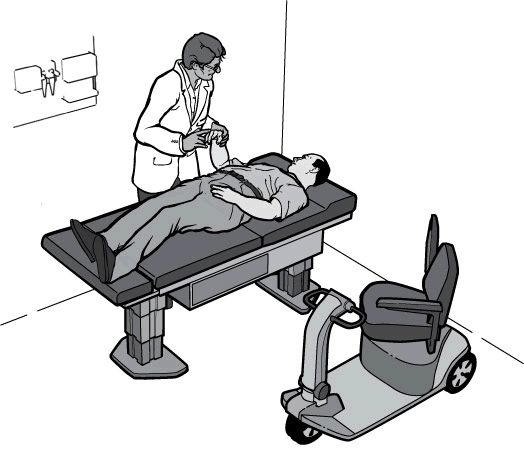
A patient with a mobility disability is examined while lying down on an adjustable height exam table.
It is essential that a person with a disability received medical services equal to those received by a person without a disability. For example, if a patient must be lying down to be thoroughly examined, then a person with a disability must also be examined lying down. Likewise, examinations which require specialized positioning, such as gynecological examinations, must be accessible to a person with a disability. To provide an accessible gynecological exam to women with paralysis or other conditions that make it difficult or impossible for them to move or support their legs, the provider may need an accessible height exam table with adjustable, padded leg supports, instead of typical stirrups. However, if the examination or procedure does not require that a person lie down (for example, an examination of the face or an x-ray of the hand), then using an exam table is not necessarily important to the quality of the medical care and the patient may remain seated.
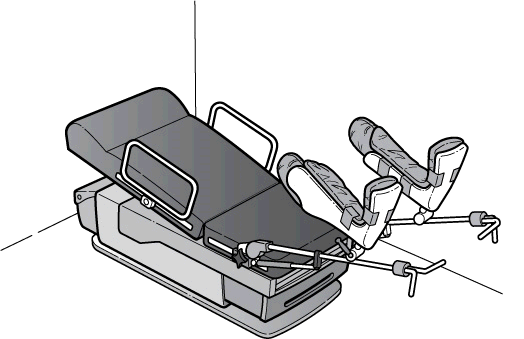
An adjustable height exam table equipped with adjustable, padded leg supports.
Evaluating the existing equipment available, the space within the examination room, the size of the practice and staff, and the patient population is necessary to determine the equipment needed to provide accessible medical care.
Exam Tables and Chairs
Traditional fixed-height exam tables and chairs (also called treatment tables or procedure tables) are too high for many people with a mobility disability to use. Individuals with mobility disabilities often need to use an adjustable-height table which, when positioned at a low height, allows them to transfer from a wheelchair. A handle or support rail is often needed along one side of the table for stability during a transfer and during the examination.
Individuals transfer to and from adjustable-height exam tables and chairs differently. Some will be able to transfer on their own by standing up from a mobility device, pivoting, and sitting down on the exam table. Those using walkers may simply walk to the exam table and sit down, while others with limited mobility may walk more slowly and need a steadying arm or hand to help with balance and sitting down. Some people using wheelchairs may be able to independently transfer to the table or chair, while others will need assistance from a staff member. Transfers may also require use of equipment, such as a transfer board or patient lift.
An accessible exam table or chair should have at least have the following:
- ability to lower to the height of the wheelchair seat, 17‒19 inches from the floor; and
- elements to stabilize and support a person during transfer and while on the table, such as rails, straps, stabilization cushions, wedges, or rolled up towels.
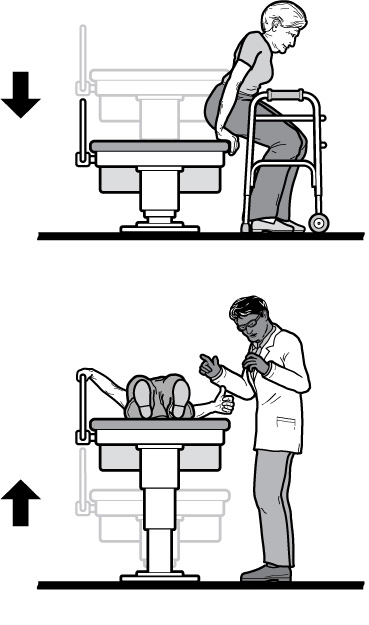
An adjustable height exam table shown in lowered and raised positions
Once a patient has transferred, staff should ask if assistance is needed -- some patients may need staff to stay and help undress or stabilize them on the table. Never leave the patient unattended unless the patient says they do not need assistance.
Different types of exam tables are used for different purposes. Some exam tables fold into a chair-like position; others remain flat. Either type can be used by people with disabilities with the right accessible features and table accessories. Pillows, rolled up towels, or foam wedges may be needed to stabilize and position the patient on the table. Tilt, adjustability, and headrests, footrests, and armrests may make the examination more accessible for the patient and also easier for the doctor.
Features of Accessible Exam Tables
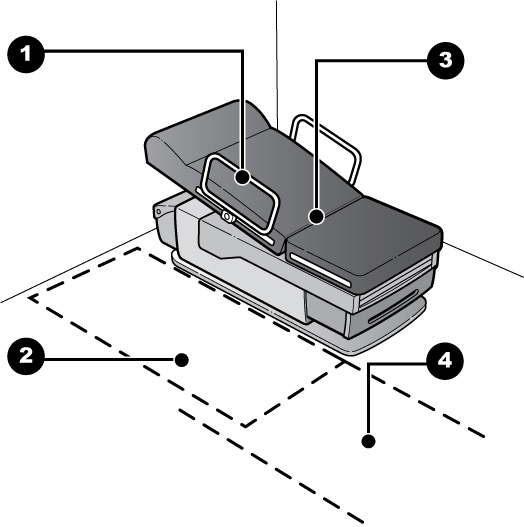
1. Removable/adjustable support rails with continuous gripping surfaces
2. 30” X 48” minimum clear floor space adjacent to exam table and adjoining accessible route
3. Exam surface lowers to 17” to 19” above the floor
4. 36” wide minimum accessible route
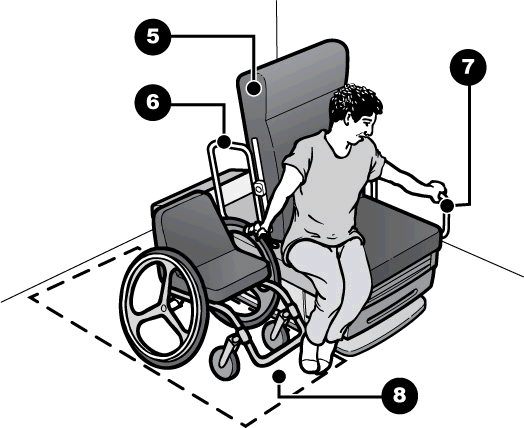
5.Exam surface may articulate to provide support during patient transfers and positioning
6.Rails/armrests can be moved for transfers
7.Rails can be added beside the table surface to assist transfers, provide support, or prevent falls
8.Space to position a wheelchair alongside table is critical for transfer
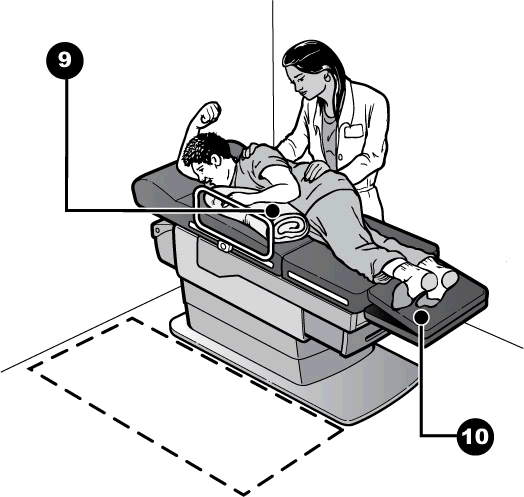
9.Positioning and support aids, such as wedges and rolled up blankets, should be available
10.Exam surface extensions, such as head and foot rests, provide additional support and positioning options
Typical Transfer Techniques: Staff Assistance and Patient Lifts
Some individuals will need additional assistance to get on and off an exam table, even if it lowers to 17‒19 inches from the floor. The kind of assistance needed will depend on the patient’s disability. The provider should ask the patient if he or she needs assistance, and if so, what is the best way to help and what extra equipment, if any, is needed.
Some individuals will need only a steady hand from a staff person in order to transfer safely to the exam table. Other individuals will need simple tools such as a transfer board (a product made of a smooth rigid material which acts as a supporting bridge between a wheelchair and another surface, along which the individual slides) or sheet. Individuals using a transfer board may need assistance from a staff person.
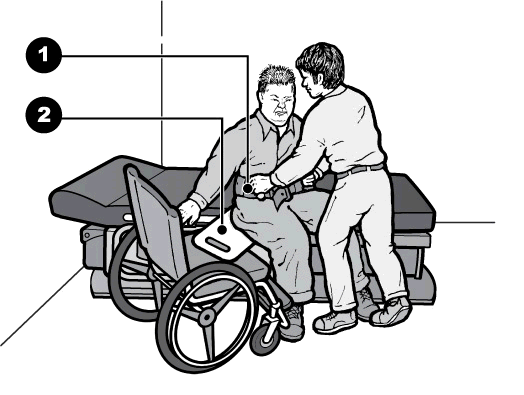
Assisted transfer using a transfer board and gait belt with handles
1.Gait belt with handles assists with guiding along transfer board
2.Transfer or sliding board acts as a bridge between wheelchair seat and table surface
Patients who can complete an independent transfer may prefer to do so for reasons of safety and simplicity.
Using Patient Lifts
Medical providers may need a lift in order to transfer some patients safely onto an exam table. Patient lifts may move along the floor or be mounted on an overhead track attached to the ceiling or to a free-standing frame. A staff person operates the lift. To use the lift, a sling is positioned under the individual while sitting in the wheelchair. Then the sling is attached to the lift so the staff person can move the individual to the examination surface. Once over the surface, the individual is lowered onto the table, stabilized, and then the sling is detached from the lift. The sling may remain under the patient during the exam or may be removed, depending on the exam. A variety of slings are available to provide different kinds of support.
Using lifts provides better security for the patient than being lifted by medical staff because there is less likelihood that the individual will be dropped or hurt in the process. Patient lifts also protect health care providers from injuries caused by lifting patients.
Portable Floor Lifts
The most common types of lifts in medical settings are portable with a U-shaped base that moves along the floor on wheels. These bases must go under, or fit around, the exam table in order to accomplish the transfer. A lift’s base may fit around the bottom end of an exam table, or fit fully or partially under the table at a perpendicular angle to the table. Some lifts are more easily operated by two or more people; others may be operated by one person. An advantage of a portable floor lift is that it can be moved from room to room and thus used with multiple exam tables. If a lift is used with multiple exam tables, the medical provider, depending on its size, may need to establish a procedure governing how the lift is shared and where it is stored. The provider should ensure that it does not schedule for the same appointment time more than one patient needing the lift. While these lifts may be less expensive than overhead lifts, they require more maneuvering space in the room and space for storage.
To properly and safely assist patients with transfers, medical staff will likely need training on how to operate the equipment and on safe patient handling techniques.
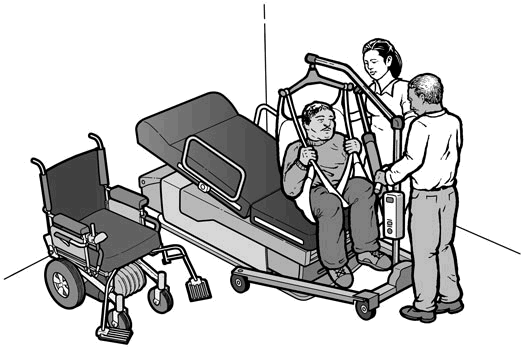
Assisted Transfer Utilizing a Portable Floor Lift
1. A low height, adjustable width base permits the lift to be positioned at the end of the examination table
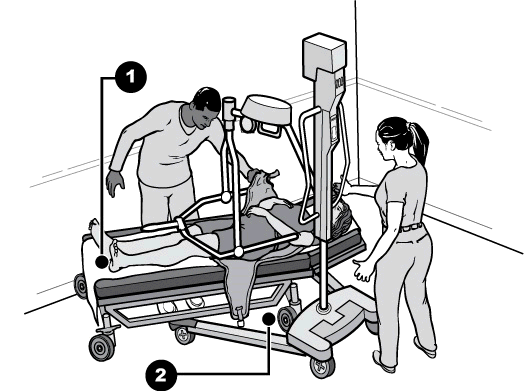
Assisted Transfer Utilizing Both a Portable Floor Lift and Movable Exam Table
1.Movable exam tables allow additional flexibility to position table and lift for optimal patient transfer
2.Clearance beneath the exam table and an angled approach of the lift allows the patient to be positioned directly over the exam table for a safe transfer
Notes for Portable Floor Lifts:
- The amount of clear floor space needed to maneuver will depend on the type of floor lift equipment used.
- Portable floor lifts must be able to position the patient over the table surface; select a model that is compatible with the exam table and room configuration.
- A low height, adjustable width base can move closer to the end of the exam table and can be narrowed for transit and storage.
Overhead Track Lifts
Overhead track lifts include ceiling mounted lifts and lifts mounted on a frame supported from the floor.
Ceiling Mounted Lifts
Ceiling mounted lifts are permanently mounted to the ceiling structure and run along one or more tracks. These lifts require no extra maneuvering space in the room adjacent to the exam table and require little storage space. However, they cannot be used in multiple exam rooms, since they are permanently attached to the ceiling structure.
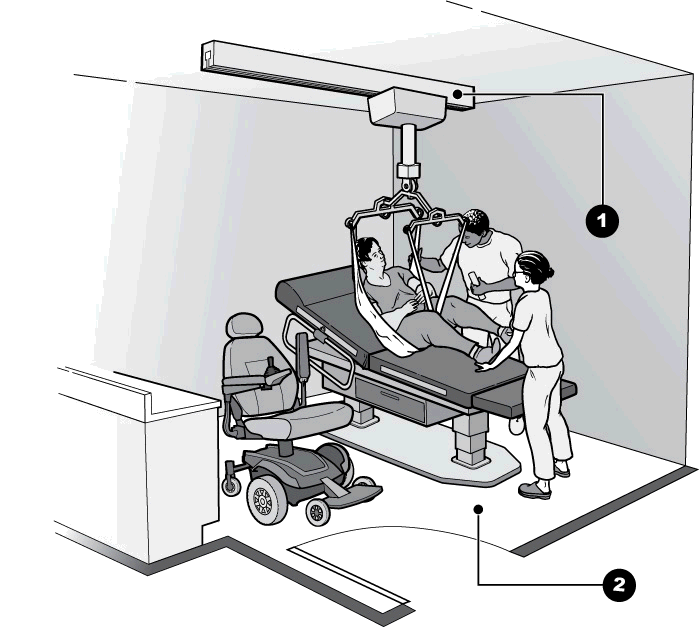
Assisted Transfer with Ceiling Mounted Overhead Track Lift
1. Ceiling structure must support weight of lift and person
2. Overhead track lifts can be used in rooms with limited floor space or where an exam table cannot accommodate a portable floor lift.
Free-Standing Overhead Lifts
Another type of overhead lift is supported from a frame that rests on the floor. Free-standing, nonpermanent overhead track lifts are a good solution when the provider does not want the lift to be permanently installed or where the existing ceiling structure cannot support a ceiling-mounted overhead lift. The medical provider should choose the type of lift that will work best with the exam tables, the space, and the ceiling or floor structure of the medical facility.
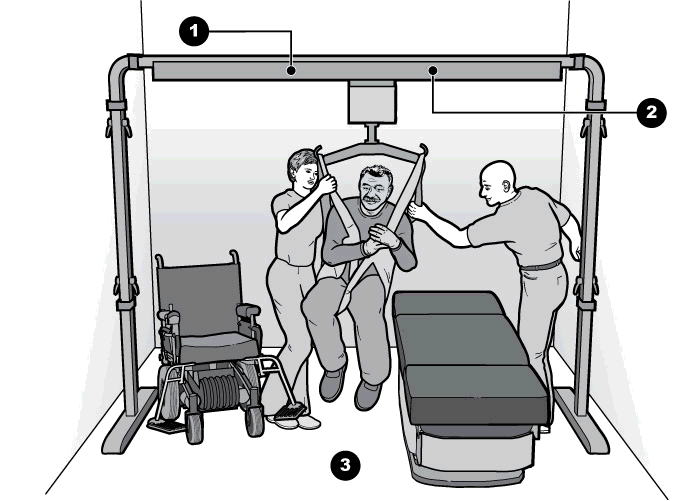
Assisted Transfer with Free Standing Overhead Track Lift
1. Free-standing overhead track lift systems function like ceiling-mounted lifts and do not require modifications to existing construction.
2. While not as portable as floor lifts with wheels, these lifts are movable and can be relocated as needs or services change.
3. An overhead lift does not require the additional maneuvering space needed by a portable floor lift.
Additional Transfer Techniques: Use of Stretchers and Gurneys
Some equipment, including radiologic equipment, lacks space underneath necessary for a portable floor lift to be used. Other equipment may be located in spaces with no room at the end of the table making it impossible to position a portable floor lift. In such cases, an overhead track lift, either permanently mounted or free-standing, may provide access to the equipment. However, metal components of these overhead lifts may not be compatible with some radiologic technologies.
When it is not feasible or possible to use a lift, another option is an adjustable-height stretcher or gurney (a table that is on wheels) that can be raised or lowered to the height of the exam table or surface. This approach involves a two step process in which the patient must transfer from their wheelchair to the stretcher, usually in a different space or area away from the equipment, and then from the stretcher to the table or surface. As many stretchers do not lower to 17” to 19” above the floor, an assisted transfer with a lift may be required to get the patient onto the stretcher. Stretchers that can be lowered to this range of typical wheelchair seat heights allow individuals capable of independent transfers a choice to do so if they prefer. Once the stretcher is positioned next to the equipment and set at the right height, many people will require assisted transfers utilizing devices such as transfer boards or slip sheets to get onto the table or surface.
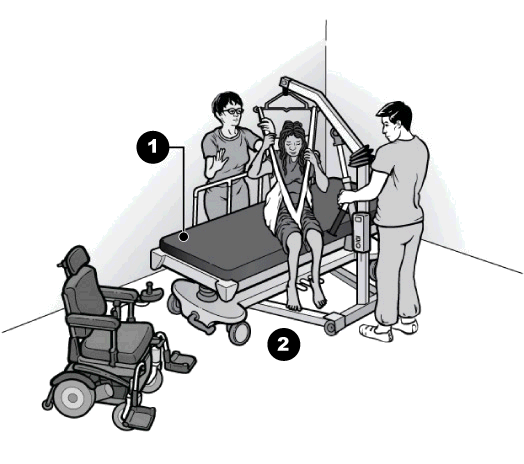
Assisted Transfer to Stretcher Utilizing a Portable Floor Lift
1.Adjustable height stretchers facilitate transfer onto radiologic equipment with a table surface. Assisted transfers from a wheelchair may require use of a lift.
2.Open space under stretcher allows close positioning of lift for transfer.
Radiologic Equipment
There are many types of radiologic technologies and equipment associated with them, including MRI, x-ray, CT scan, bone densitometry, mammography, and ultrasound. Most of these technologies require the patient to lie on a flat surface that is part of the equipment. The accessibility issues related to transfer to the surface are similar to those addressed previously under Examination Tables and Chairs. However, because the technology is often integrated into the table, the table may not be able to be lowered sufficiently. In these cases, use of a patient lift or another transfer and positioning technique is particularly important for access to this equipment.
Many radiologic technologies also require the patient to keep still, which may be very difficult for some individuals with a mobility disability, including those with spasticity, tremor, or other condition. Patients may need a staff person to support them with pillows, rolled up towels, wedges, or by holding onto them.
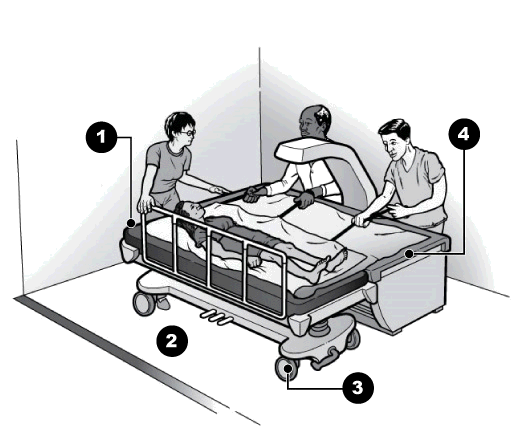
Assisted Transfer to Densitometer Utilizing a Stretcher
1. Set stretcher height to be level with table surface for lateral transfer.
2. Adequate floor space to maneuver and position stretcher.
3. Stretcher locked in place to prevent movement during lateral transfer.
4. Slip/slide sheets, boards, or other aids assist with lateral transfers.
Mammography Equipment
A mammography exam typically requires the patient to stand up. Individuals who use wheelchairs will need to have an exam while staying in their wheelchair. The mammography machine will need to adjust to their height and accommodate the space of the wheelchair. People who walk with a mobility device or who cannot stand for prolonged periods of time may need to sit in a chair with adequate support, locking wheels, and an adjustable back and, like people who use wheelchairs, need the machine to adjust to their height once seated. Additionally, some patients may need support to lean forward.
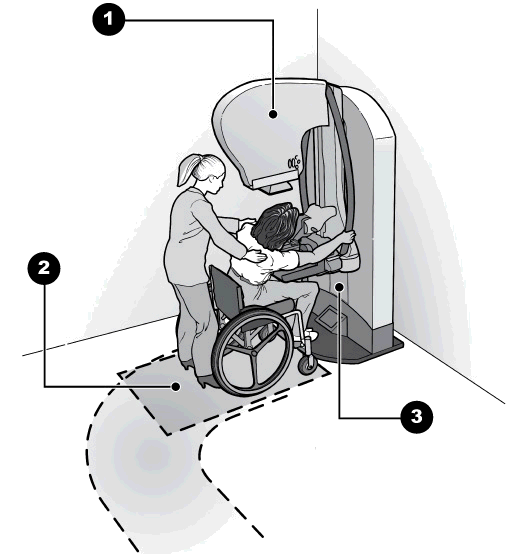
Accessible Mammography Machine
1.Unit pivots to multiple angles and adjusts in height for seated patients.
2.It is best to position equipment to allow both front and side approaches; for some patients a side or angled approach may be better for positioning at the camera unit and plate.
3.Clearance is needed beneath the camera unit and plate to allow people using wheelchairs and other mobility devices to pull up to the equipment.
Scales
A patient’s weight is essential medical information used for diagnostics and treatment. Too often, individuals who use wheelchairs are not weighed at the doctor’s office or hospital, even though patients without disabilities are routinely weighed, because the provider does not have a scale that can accommodate a wheelchair. Medical providers should have an accessible scale with a platform large enough to fit a wheelchair, and with a high weight capacity for weighing an individual while seated in his or her wheelchair. Other options may include a scale integrated into a patient lift, hospital bed, or exam table.
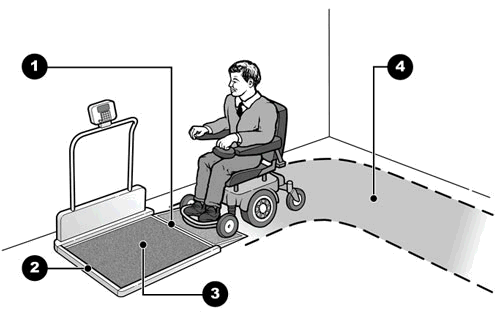
Accessible Scale
1.Sloped surface provides access to scale platform -- no abrupt level changes at floor or platform.
2.Edge protection at drop off.
3.Large platform to accommodates various wheelchair sizes.
4.Provide maneuvering space to pull onto and off scale.
The previous information provides guidance on the ADA’s requirement to provide accessible health care to individuals with mobility disabilities as well as illustrated examples of accessible medical equipment, room and office configurations, and lifting and transfer equipment and techniques. This guidance, when applied and adapted to the specific needs and circumstances of individual health care providers, can help ensure that people with mobility disabilities have an equal opportunity to receive accessible health care services.
Staff Training.
A critical, but often overlooked component to ensuring success is adequate and ongoing training of medical practitioners and staff. Purchasing accessible medical equipment will not provide access if no one knows how to operate it. Staff must also know which examination and procedure rooms are accessible and where portable accessible medical equipment is stored. Whenever new equipment to provide accessible care is received, staff should be immediately trained on its proper use and maintenance. New staff should receive training as soon as they come on the job and all staff should undergo periodic refresher training during each year.
Finally, training staff to properly assist with transfers and lifts, and to use positioning aids correctly will minimize the chance of injury for both patients and staff. Staff should be instructed to ask patients with disabilities if they need help before providing assistance and, if they do, how best they can help. People with mobility disabilities are not all the same - they use mobility devices of different types, sizes and weight, transfer in different ways, and have varying levels of physical ability. Make sure that staff know, especially if they are unsure, that it is not only permissible, but encouraged, to ask questions. Understanding what assistance, if any, is needed and how to provide it, will go a long way toward providing safe and accessible health care for people with mobility disabilities.
For more information about the ADA, please visit our website or call our toll-free number:
ADA Website - - www.ada.gov
ADA Information Line
800‒514‒0301 (voice)
800‒514‒0383 (TTY)
24 hours a day to order publications by mail
M-W, F 9:30 a.m. – 5:30 p.m., Th 12:30 p.m. – 5:30 p.m. (eastern time) to speak with an ADA Specialist.
All calls are confidential.
For more information about Section 504,
visit the Department of Health and Human Services Office for Civil Rights website at:
www.hhs.gov/ocr.
A list of HHS OCR regional offices near you can be found at:
www.hhs.gov/ocr/office/about/rgn-hqaddresses.html.
Section 504’s requirements for new construction and alterations to buildings and facilities are found at 45 C.F.R. Part 84, Subpart C for receipients of federal financial assistance. The regulations are available at:
www.hhs.gov/ocr/civilrights/resources/laws/index.html.
For persons with disabilities, this publication is available in large print, Braille, audio tape, and computer disk.
July 2010

User Comments/Questions
Add Comment/Question